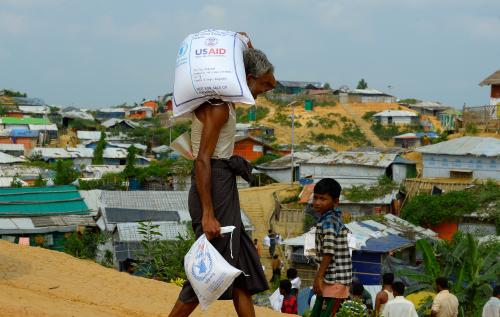In the early 1990s while working on the transition in the former Soviet Union, I perceived a fundamental difference between the Soviet and Western approaches to information. Both saw information as power. But the Soviet approach was to protect it, to keep it hidden, and to not let competitors or even colleagues share this “power.” The Western approach was to share information, to build on the information of others, and then share it back. The difference between these approaches was in seeing the world as having “win-win” opportunities or as a zero-sum game.
The data revolution is win-win.
The Quadrennial Diplomacy and Development Review
The QDDR team is charged with identifying a few goals that are visionary but also practical and achievable. An obvious candidate is to bring the Department of State and USAID into the “data world.” It is visionary in that it is the future, a future that is actually already upon us. It is practical because it would improve how the agencies operate. It is doable because there are models right at hand that can demonstrate the why, the what, and the how—the Millennium Challenge Corporation (MCC) and the President’s Emergency Plan for AIDS Relief (PEPFAR).
MCC and PEPFAR were born with data in their DNA. They have come to understand that data is not just nice to have, but essential to performing and protecting their mission.
They have taken a further step in realizing that data is not only important for decision-making and management, but also can be regularly shared with others and systems can thus be improved. Making data public and decision-making transparent fosters greater accountability and strengthens its benefits by allowing better understanding of performance by stakeholders and partners. This simple yet essential exercise builds a protective shield around their mission.
The Use of Data by the Millennium Challenge Corporation
MCC was designed around using solid data to drive decision-making. Data is used from the beginning, with the choice of countries that are eligible for MCC assistance. The country selection process is driven by an annual evaluation of countries according to a scorecard of 20 indicators of country performance. The data used is publically available third-party data and the scorecard is made public, so anyone can check the analysis. The MCC board uses these results, along with other information, in determining country eligibility. The board’s decisions are not slavishly driven by the data, but, because that information is rigorous and public, it has to have a pretty good rationale for variance from the results of the data.
Once a country is deemed eligible, hard economic and social analysis is used throughout the process of developing a MCC compact and projects in order to identify the most effective use of the MCC investment. These data-driven steps include:
- A constraints analysis identifies binding constraints to economic growth. That analysis is used to identify the sectors where investments would be most likely to promote poverty-reducing growth.
- Program logic is used to show how a project is expected to raise household incomes and is used to inform project design and evaluation.
- Cost-benefit analysis estimates expected returns from each proposed project, as the MCC is looking for projects that both increase economic growth and reduce poverty. This analysis allows for calculation of an expected economic rate of return.
- Social and gender analysis and beneficiary analysis are integrated to determine how the project will impact on different gender and income groups.
- All of that data collection and analysis happens before projects are approved and investment begins. Once the projects begin, then data is used to monitor and evaluate—monitoring progress on a quarterly basis, and then evaluating a project’s results at the end.
Data Transparency at the MCC
Just as data has been a by-word for the MCC, so has transparency. The MCC has made public much of its analyses and the data on which they are built. It also makes available the evaluations of projects and recently the data that underlies those evaluations, including household survey data.
The MCC has been the leader in fulfilling the U.S. government’s commitment to making its foreign assistance data comparable and transparent, through both the Foreign Assistance Dashboard and the International Aid Transparency Initiative (IATI). In the four years that Publish What You Fund has scored donors in the annual Aid Transparency Index (ATI), the MCC has consistently ranked among the top 10 most transparent donor organizations globally (Full disclosure: I chair Publish What You Fund’s U.S. advisory council). In 2013, the MCC leadership made the decision that aid transparency was of such benefit to both its partners and itself that it must robustly meet the IATI standard. That year, ATI ranked the MCC number one among all donors. It fell to number three in 2014 only because several other donors made a few extra strides.
The President’s Emergency Plan for AIDS Relief
PEPFAR has always been results-focused, generating reams of data, but not always using that data to effectively manage and improve its programs, nor sharing it broadly. That all changed in April of 2014 when retired Colonel Deborah Birx, M.D., became the U.S. global AIDS coordinator. She came to the job with medical and military experience, using data as the basis for decision-making and action, and is now infusing that culture more deeply into PEPFAR.
She has driven a new strategic plan, PEPFAR 3.0, which commits to very specific outcomes over the next three years and enhances PEPFAR’s use of data. The focus for the 2015 Country Operational Plans is on data use and analysis, with a goal of reducing the plans from hundreds or thousands of pages to a more manageable and readable product that is grounded in data. She is demanding that decisions be based on data on expenditures, impact and results, and quality.
Importantly, she is driving the collection of data down to the site level and using that data to inform decisions as to where and where not to put resources—thereby creating the ability to target scarce resources where they will have the greatest impact—at the sub-national level.
And, Birx is sharing the data. She has brought PEPFAR into the data transparency world and sees this as a means to hold PEPFAR accountable and to improve the performance of its partners and stakeholders.
It may sound simple, but the impact can be dramatic, very practical, and life-saving: collect data at the village and clinic level, share that data broadly so all parties can use the data to better target their resources, and evaluate how the resources are being deployed so as to use that information to maximize results in epidemic control.
Ambassador Birx demonstrates the impact that a strong leader with vision can have. PEPFAR ranked number 50 in the 2013 ATI. She assumed her new position less than three months before the assessment for the 2014 ATI. She put the charge to her staff, and after a few, albeit hectic, weeks of effort, produced results that saw PEPFAR rise to number 30 in the 2014 Index. PEPFAR is committed to continuing this momentum of data transparency, with the ultimate goal being 100 percent IATI compliant.
Building Data Hubs & Data 2X
The MCC and PEPFAR’s commitment to data is demonstrated by two recent collaborative initiatives. On World AIDs Day, Secretary Kerry announced that the MCC and PEPFAR would create country-driven data hubs in select countries. The hubs will have local boards and both a physical space for data analysts and virtual engagement among stakeholders. The purpose is to make data broadly available in the country, build local capacity of government and civil society, and deliver on transparency, accountability, and sustainability.
The MCC and PEPFAR have also joined the Data 2X initiative, designed to advance gender equality and women’s empowerment by building partnerships to improve sex aggregated data collection and use. In December 2014 PEPFAR released as part of 2X unprecedented age-by-sex disaggregated data. This new data shows the extent to which PEPFAR is reaching young women in various capacities around HIV care, treatment, and prevention to help focus programs on this target population.
The Benefits of Data and Transparency
Consider why MCC and PEPFAR are so driven by data and transparency. The benefits are considerable:
Decision-making. Decisions are informed by facts and therefore more closely reflect reality and produce better outcomes.
Accountability. Data and information made publically available forces the agency to hold itself accountable, allows stakeholders to better hold it accountable, and enhances understanding of agency programs.
Mission. Good data made transparent keeps the agency and its stakeholders true to its mission, as any divergence becomes readily apparent. It inoculates the agency against the steady lobbying of ambassadors, White House, Congress, and countries for special treatment. It provides the MCC and PEPFAR with bipartisan support as they avoid the aura of being a “black box,” because much of the basis for their decision-making is transparent and known, as are the program results.
The QDDR Can Drive Data Transparency
This essay has catalogued the actions—and the reasons behind those actions—of the MCC and PEPFAR to use and share data for decision-making. These organizations show that using data in such a way is doable, can improve agency results and accountability, and can garner political support.
Both USAID and the State Department are working on action plans to identify a path forward to meet the aid data transparency commitments. Reinforcement from the QDDR would be timely and bolster those efforts.
The QDDR would be hard-pressed to find an objective that offers more immediate impact and is ready to be acted upon. And it is unthinkable not to embrace quality data and transparency.
The Brookings Institution is committed to quality, independence, and impact.
We are supported by a diverse array of funders. In line with our values and policies, each Brookings publication represents the sole views of its author(s).



Commentary
QDDR II: Bring U.S. Foreign Aid Into The Data Revolution
January 15, 2015